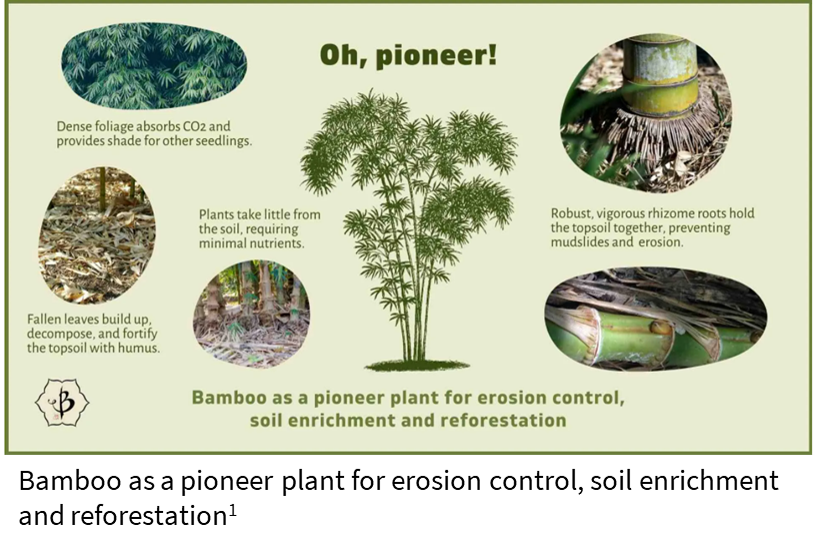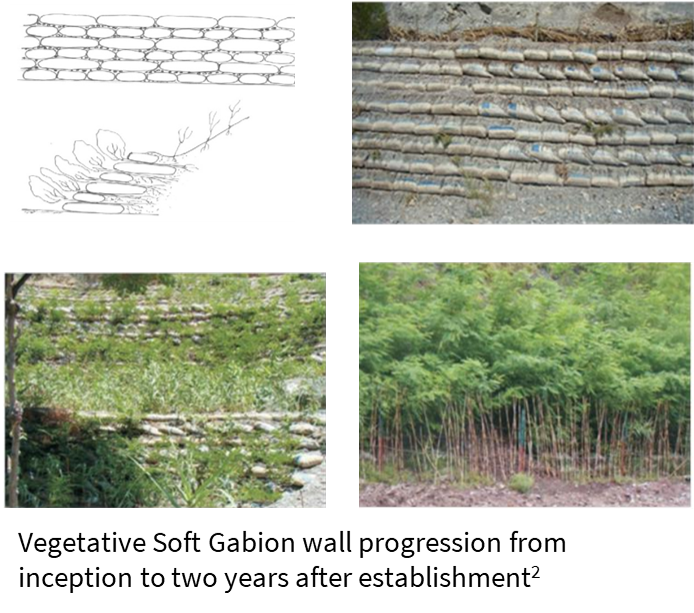Riverbank erosion is a naturally occurring process where water wears away the banks of the river. However, increased human and animal activity with poor management of riverbanks have increased the rate of erosion. With no protective shield (vegetation or fencing), erosion can lead to riverbank failure. There are many ways by which riverbank erosion mitigation works can be carried out:
- Physical bank stabilisation using bamboo or soil bioengineering (e.g. soft or vegetative gabions).
- Riparian revegetation and bush regeneration including native species of grass or trees.
- Stock management such as fencing or cattle gates to reduce animal activity
To control riverbank erosion, it is best to use a combination of techniques.
Bank stabilisation can be undertaken in a variety of ways:
- Bamboo plantation along the banks: Bamboo is widely used for soil protection because it grows rapidly
 and has a strong root system. It can be used in a variety of soil profiles and types. Two types of Bamboo varieties - Common Bamboo (Bambusa vulgaris) and Pacific Bamboo (Schizostachym glaucifolium) – are commonly used in the Pacific.
and has a strong root system. It can be used in a variety of soil profiles and types. Two types of Bamboo varieties - Common Bamboo (Bambusa vulgaris) and Pacific Bamboo (Schizostachym glaucifolium) – are commonly used in the Pacific.
- Soil bioengineering structures for riverbank erosion: Soil bioengineering methods integrate civil
 engineering techniques with natural materials to obtain fast, effective and economic methods of protecting, restoring and maintaining riverbanks. Two types of soil bioengineering structures used for riverbank erosion control are: retaining walls and spurs. Retaining walls and spurs can be gabion (civil engineering structure filled with earth and stones), stone or combination of vegetation and gabion/stone.
engineering techniques with natural materials to obtain fast, effective and economic methods of protecting, restoring and maintaining riverbanks. Two types of soil bioengineering structures used for riverbank erosion control are: retaining walls and spurs. Retaining walls and spurs can be gabion (civil engineering structure filled with earth and stones), stone or combination of vegetation and gabion/stone.
Riverbank stabilization using vegetation and bioengineering implementation is low cost. Whilst providing cost estimates is difficult given the broad range of influencing factors across the Pacific, the below table outlines the key components that should be taken into account when estimating an bioengineering riverbank stabilisation project budget for a specific location.
|
|
|
|
|
|
|
|
||||
|
|
|
|||
|
|
|
|||
|
|
|
|||
|
|
|
|||
|
|
|
|||
|
|
||||
|
|
|
|||
|
|
|
Riverbank stabilisation using vegetation and bioengineering is compared to hard infrastructure like channel concreting. Comparisons between these approaches include:
- Bamboo plantation or soft gabions are often cheaper
- Bamboo plantation reduces sediment flowing in the river and prevents erosion.
- Bamboo complex root system acts as a water filtering system thus maintaining the river water quality.
- -
Transfer of Pakistan’s Experience in Soil Bioengineering for Slope Stabilization to TimorLeste, South – South Experience Exchange. See https://documents1.worldbank.org/curated/en/411851468287165000/pdf/NonAsciiFileName0.pdf
- -
Mainstreaming ecosystem services and biodiversity into agricultural production and management in the pacific islands. See https://www.fao.org/3/i6505e/i6505e.pdf
- -
International Bamboo and Rattan Organisation. See https://www.inbar.int/bamboo-sids/
- -
The Use of Bamboo for Erosion Control and Slope Stabilization: Soil Bioengineering Works. See https://www.intechopen.com/chapters/60430
- -
1. Growing bamboo for erosion control. See https://bambubatu.com/growing-bamboo-for-erosion-control/
- -
2. Transfer of Pakistan’s Experience in Soil Bioengineering for Slope Stabilization to TimorLeste, South – South Experience Exchange. See https://documents1.worldbank.org/curated/en/411851468287165000/pdf/NonAsciiFileName0.pdf
Case study
Riverbank erosion control for Waimanu River
Waimanu River is one of the three rivers draining large amounts of freshwater into the Rewa River. It is also one of the drinking water sources for the Fijian central island of Viti-Levu. The riverbank has been eroded which affects the river system as well as the livelihood of communities. The community have stopped using the eroded riverbank for any recreational activity and houses near the bank are prone to landslide during the rainy season. During heavy rainfall events, the high turbidity of the river affects the availability of freshwater fish, eel and mussels.
As part of the Fiji Ridge-to-Reef project, Vertiver grass was introduced to prevent soil erosion and support water retention along the riverbank. Vertiver grass grows fast, is strong and grows large root networks which holds the soil together.
The grass planted on the riverbank has successfully stabilised the bank, reduced channel widening, reduced excessive sedimentation and helps ensure freshwater fish availability.
Reference: Riverbank erosion control for Fiji’s Waimanu River, https://www.pacific-r2r.org/news/riverbank-erosion-control-fijis-waimanu-river
